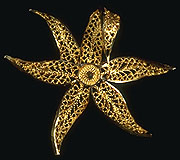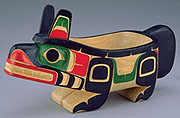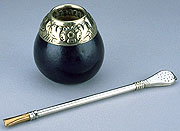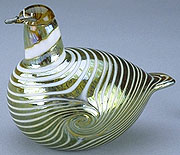
 |
CMC LH991.1060.107
The Javier and Marcela Perez de Cuellar Collection consists of 168 heritage objects representative of member countries of the United Nations. Mrs. Perez de Cuellar, wife of the former United Nations Secretary-General Javier Perez de Cuellar, is to be credited for having assembled the collection during her husband's term in office from 1982 to 1991.
CMC LH991.1060.102
The collection covers the entire spectrum of designs and trends of the past and the present. It encompasses virtually every sort of artistic, decorative and utilitarian object. It includes a wide range of pottery and porcelaine, lovely boxes, wood carvings and boat models, basketry and tapestries, lace, metalwork (including silver), glass, articles of personal adornment and work in semi-precious stones. As the photos show, the very heart of native Canadian culture is to be found in the Wolf Bowl. Characteristic of Argentina is the Bombilla and Maté Gourd set. From Ghana a new international element has been introduced with a carved-in insignia of the United Nations on the seat of an ancient form of stool that dates to legendary times. The delicate lines of the poised bird from Finland illustrate the vision and skill of its thoroughly-modern creator Oiva Toikka.
|
 |
Canada: Bowl (Wolf) CMC LH991.1060.89
This small food utensil is an emblem of the household. It is used in feasts and sometimes in everyday life. A wolf bowl is a delineator of Kwakwaka'wakw culture, where bowls have been a traditional cultural item. A stylized form of a wolf is painted in red and green. The top of the snout, the tail and the border are black. The wolf has several teeth, a rounded eye, nose stretched forward, ears pointed upwards. Rank is expressed in the art form. It is rank and social position that allows for the use of the totemic wolf figure on the bowl. In tales of the mythical animal world, Wolf is one of the most important animals as a source of supernatural gifts bestowed upon Kwakwaka'wakw heroes.
|
 |
Argentina: Bombilla and Maté Gourd Set CMC LH991.1060.93 a,b
This container is a genuine folkloric utensil made from a nearly perfectly-shaped gourd. The top was lopped off to form an opening at one end that is covered with a rim of decorated silver. The interior was hollowed out and feels smooth to the touch from the dried pulp. The outer shell is smooth. It has a rounded bottom that sits well in the palm of the hand.
Maté is traditionally sipped through a maté sipper called a Bombilla. This special slender tube comes with a flat spoon-shaped strainer that is perforated on both sides with tiny holes at the bottom end. The strainer is placed at the bottom end of the gourd and prevents leaves from entering the tube. Bombilla and Maté Gourd Sets are sometimes collected and some are embellished with gold.
What is Maté?
Maté is a tea-like substance made from the dried leaves of a native holly tree and/or from a plant that grows wild along river banks. It is caffeine-loaded. The gourd is filled with hot (but not boiling) water, the tea is left to steep and is slowly sipped. Custom and ritual practice dictate that the gourd gets passed around and each person present gets a sip of the Maté, a gesture that is intended to enhance good fellowship. This tea is the national beverage of Argentina. It is also drunk all over South America and was in use by Native peoples long before the arrival of Europeans.
|
 |
Ghana: Stool CMC LH991.1060.132
This stool, in traditional style, is made of a light-colored wood and varnished to gold. Ghanaian folklore depicts a stool as a symbol of power - even godhood. Power is reflected in the choice of a stool where a leader would sit in repose. Sitting is associated with order, the seated position with enthronement. Stools have an important role and a sacred character, in addition to a symbolic and a utilitarian one. They are used in a variety of functions: from state occasions to those that regulate local affairs. They are found at the centre of many rituals, where their function is to make life more secure.
|
 |
Finland: Sculpture (duck) CMC LH991.1060.81
The name of the sculpture is "Alli", a long-tailed duck created by Oiva Toikka. It is one of Toikka's (1980) series of "Birds". Alli was designed in 1980 and produced in 1988. It is a model that is still in production by popular demand. The outstanding Finnish glass designer is recognized as an artist of the first order whose art has found its place in the showcases of collectors.
See more of the Perez de Cuellar Collection
|

![]()

![]()